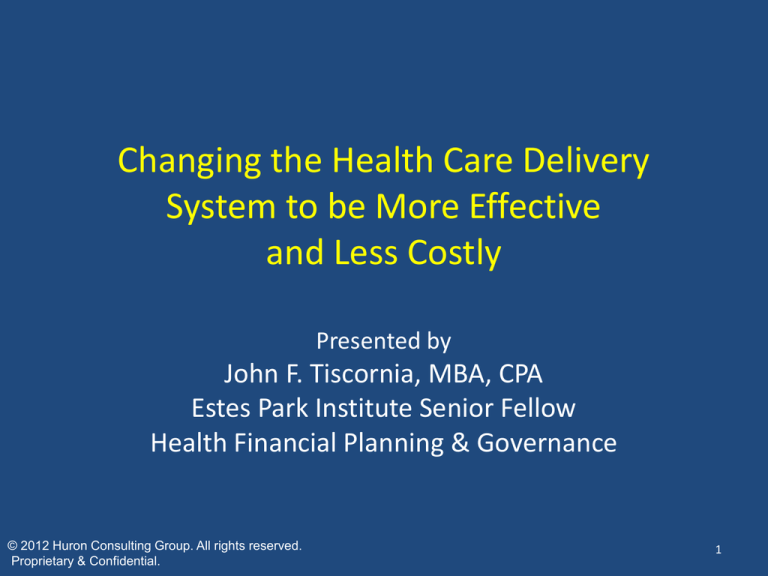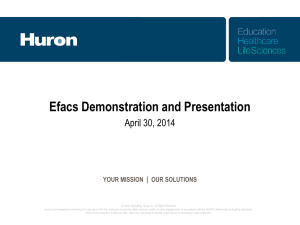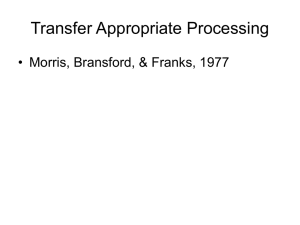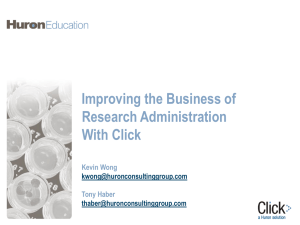
Changing the Health Care Delivery
System to be More Effective
and Less Costly
Presented by
John F. Tiscornia, MBA, CPA
Estes Park Institute Senior Fellow
Health Financial Planning & Governance
© 2012 Huron Consulting Group. All rights reserved.
Proprietary & Confidential.
1
Objective
• Provide participants with strategies and practical
approaches for reducing the rate of healthcare cost
increases, while maintaining and improving quality of
health care.
2
Outline
Current Financial State of Hospitals
Trends
The Second Curve
Market Demands
Case Studies
Setting the Foundation
Changing the Delivery Model
Integration and Portfolios
Next Steps
Focus on Fundamentals
3
Current Financial State of Hospitals
Stand-Alone Hospitals & Single-State Healthcare Systems Medians
2011
Net patient revenues (mil $)
2010
2009
2008
504.0
469.9
453.6
426.8
Operating margin (%)
2.5
2.4
2.3
2.0
Excess margin (%)
4.9
4.7
4.6
4.3
Debt service coverage (x)
4.4
4.3
4.1
4.1
165.0
159.8
146.8
145.9
Cushion ratio (x)
14.9
14.3
13.3
12.8
Accounts receivable (days)
45.1
44.3
45.8
48.6
Payment period (days)
58.6
56.9
56.8
56.6
Average age of plant (years)
10.5
10.2
9.9
9.8
Debt to capitalization (%)
40.4
41.6
42.1
41.1
Capital spending ratio (x)
1.2
1.1
1.3
1.6
Cash on hand (days)
Source: Moody’s Investors Service
Not-For-Profit Healthcare Medians for FY 2011
Current Financial State of Hospitals
Stand-Alone Hospitals and Single-State Systems Median Ratios by Rating Category “A”
2011
Sample Size
Net patient revenues (mil $)
Your Hospital
At 12/31/2014
198
544.1
Operating margin (%)
2.7
Excess margin (%)
5.7
Debt service coverage (x)
5.0
Days cash on hand
187.2
Cushion ratio (x)
17.2
Accounts receivable (days)
45.1
EBIDA margin (%)
Average age of plant (years)
10.2
Debt to capitalization (%)
37.9
Capital expense (%)
1.2
Source: Moody’s Investors Service
Not-For-Profit Healthcare Medians for FY 2011
5
Leading the Transition
Curve 1
– All about volume
– Reinforces silos
– Little incentive for real
integration
– Shared saving program
– Bundled payments
– Value-based
reimbursement
– Rewards integration,
quality, outcomes, and
efficiency
Performance
Curve 2
Curve 2
Curve 1
Natural
Trajectory
Time
6
Second Curve Performance Improvement
Still a lot left on the table in performance improvement efforts even in
high-performing organizations.
Second curve performance improvement is more complex and
intense, but the potential yields – financial, cultural, operational – are
greater than ever before
Shift from optimizing current operations to re-imagining and retooling operations to achieve the IHI Triple Aim (patient
experience/cost/quality, population health, cost)
© 2012 Huron Consulting Group. All Rights Reserved.
Proprietary & Confidential.
7
Market Will Demand 20 to 40% Improvement
COMPELLING NEED TO DEVELOP A MULTI-PRONGED APPROACH
Performance
Improvement
8-12% total Improvement
Market Drivers:
Clinical
Transformation
6-14% total Improvement
PAYMENT REFORM
COST PRESSURES
INFORMATION BOOM
IMPROVED CARE
Scale &
Integration
4-8% total Improvement
Asset
Rationalization
3-6% total Improvement
© 2012 Huron Consulting Group. All Rights Reserved.
Proprietary & Confidential.
8
One Hospital’s Success Story
• Results for 5 months:
– Operating revenue up $14.4M vs. prior year; Why?
• Revenue Cycle best practices
• Better administration of managed care contracting
• 3% rate increase from a major payer
– Operating expense down $9.1 million; Why?
• EVERY line item is down (except Medical fees and
depreciation)
– Operating income improved $23.5M
– Net assets up $30M
– Cash up $25M
9
Total Expense Per Adjusted Patient Day
Supply Expense Per Adjusted Patient Day
2010 The Situation
Assessment of ???? Healthcare
Current Situation
9.5% Margin YTD
Lessons Learned
• Medical Staff Involvement
• Communication
Setting the Foundation
16
Building a Burning Platform
CRITICAL ELEMENTS
Ownership by the business units (vs. finance)
Clearly outlined and delivered by the CEO
Clearly defined:
• Targets
• Roles and responsibilities
• Timelines
Frequent communication on actual performance to plan
Sustainability
© 2012 Huron Consulting Group. All Rights Reserved.
Proprietary & Confidential.
17
Building a Burning Platform
OWNERSHIP BY THE BUSINESS ENTITIES VS. FINANCE
Develop the Case • Quantify the impacts of likely reimbursement, revenue and cost
for Change
pressures
• Articulate the likely local, regional, and national change drivers
• Include key leaders from throughout the organization (fosters
later buy-in)
Create and Monitor • Impact on revenue of exchanges, bundled payments, value
a Multi-Year
based pricing, etc. and expected expenses by entity
Financial Model • Summarize in one page table
CEO & COO Share the • Executive (expectations by entity)
Message With the • Physicians and employees
Organization • Email, town hall, webcasts, etc.
Communicate • Mission and engagement model
• Roles and responsibility
• Next steps
© 2012 Huron Consulting Group. All Rights Reserved. Proprietary & Confidential.
18
Communication Strategy and Plan
Adaptable, working communication plan
Builds the case for change
Focuses on local communications with local leaders delivering
messages
Promotes personal communications with many key audiences
Proactive and transparent with target audiences
Ongoing communication to highlight developments and successes
Targeted messages for each audience
Use multiple venues and forums for communication
© 2012 Huron Consulting Group. All Rights Reserved.
Proprietary & Confidential.
19
High-Level Communication Plan
Stakeholder Group
Messaging Goal(s)
Communication
Methodology(s)
Minimum
Frequency/Timing
Project Sponsor
Detailed project updates
and guidance
In person meetings
Weekly
Leadership Team
Steering Committee
Project progress; stakeholder
input; ensure alignment
with other initiatives
In person meetings
Every 3-4 weeks
Boards of Trustees
Project progress; stakeholder
input; ensure alignment
with HS initiatives
In person meetings
As appropriate
Department Chair
meetings; Physician
survey
Monthly
Department and Unit
Administrators
Project progress; stakeholder
input; input on administrative
challenges; communicate
changes
Project progress; stakeholder
input; communicate changes
Staff
Project progress;
co mmunicate changes
Community At Large
Project progress;
communicate changes
Department Chairs /
Physicians
© 2012 Huron Consulting Group. All rights reserved.
Proprietary & Confidential.
Department Administrator
meetings
Town Hall meetings;
Project website;
newsletters
Town Hall meetings;
Project website
Every 4-6 weeks
Monthly
2-3 meetings after
initial assessment
20
Establish a Performance Improvement Office
RESPONSE TO BARRIERS
What is the Performance Improvement Office (PIO)?
• A strategic response to align, coordinate and focus resources (e.g.
decision support, lean teams, PMO etc….)
• Internal partner to assist in planning and provide implementation
resources where necessary
• An organization focused on system wide process improvement and
best practices
• An empowered organization reporting to the CEO/COO/CFO
• Results driven with disciplined benefits measurement
© 2012 Huron Consulting Group. All rights reserved.
21
Assessment Feasibility:
Overall Impact by Year
Overall Operations Improvement Plan Feasibility Assessment
Total Dollars: $122.9M
Unachievable in 2012
35%
$43.0M
$67.6M
Achievable in 2012
55%
$12.3M
Questionable
10%
**Approximately $9M of the “Unachievable” will not be realized in future years
© 2012 Huron Consulting Group. All Rights Reserved.
Proprietary & Confidential.
22
Conceptual Model
IMPACT OF DIFFERENT PERFORMANCE IMPROVEMENT STRATEGIES
6.00%
Income from Operations
4.00%
Close gap
through
changes in
delivery
2.00%
0.00%
-2.00%
-4.00%
-6.00%
-8.00%
FY 2011
FY 2012
FY 2013
FY 2014
FY 2015
FY 2016
23
Legend for Conceptual Model Slide
Target Operating Margin
Projected Operating Margin
Traditional Performance Improvement
Traditional PI + UM/CM/LOS
Traditional PI + UM/CM/LOS + Appropriateness of Services
Traditional PI + UM/CM/LOS + RC + MD Alignment
24
Next Steps
•
•
•
•
•
•
•
Recognize the situation
Build Burning Platforms
Develop Communication Plan
Involve the Organization and Physicians
Establish P.I.O.
Prepare Strategy for Second Curve
Develop a Culture of Change
…. “There is nothing more difficult to take in hand, more
perilous to conduct, or more uncertain in its success, than to
take the lead in the introduction of a new order of things.
Because the innovator has for enemies all those who have done
well under the old conditions, and lukewarm defenders in those
who may do well under the new.”
Nicolo Machiavelli; The Prince, 1532
2
6
Focusing on the Fundamentals
© 2012 Huron Consulting Group. All Rights Reserved.
Proprietary & Confidential.
27
Clinical Transformation – 6 to 14% Improvement
TYPICAL IMPROVEMENT AND IMPLEMENTATION COMPLEXITY
Initiative
CLINICAL EFFICIENCY
Typical Benefit
Ease of
Implementing
Income statement benefit of 2% - 4%
Case Management
Medium
Interdisciplinary Care Coordination
Medium
Patient Placement
Medium
House Management (Bed Turnaround, Transportation
CARE VARIANCE MANAGEMENT
Easier
Achieved a 5 – 25% reduction in LOS in targeted DRGs
Targeted DRGs (COPD, Sepsis, Heart Failure, etc.)
Harder
Targeted Tests & Treatments across all DRGs (Blood Utilizn.)
Harder
Critical & Intermediate Care Utilization
Harder
SURGICAL FLOW
Income Statement benefit of 1% - 3%
Surgical Scheduling
Easier
Pre-Admission Services
Easier
Asset Management
Medium
Care Delivery
Medium
EMERGENCY DEPARTMENT FLOW
30% - 35% reduction in waiting time
Intake Process
Medium
Patient Flow
Medium
28
Workforce Opportunities – 5 to 10% Improvement
TYPICAL IMPROVEMENT AND IMPLEMENTATION COMPLEXITY
Initiative
Expense
Improvement
Ease of
Implementing
Expense
Improvement
Ease of
Implementing
Surgical Services
4%
Harder
Home Care Services
3%
Easier
Human Resources
3%
Medium
Fiscal Services
2%
Medium
Facility Services
2%
Medium
Pharmacy Services
2%
Harder
Information Technology
2%
Harder
Benefits Expense –
Medical
7%
Medium
Initiative
LABOR DEPT. (Continued)
LABOR-SYSTEM
Position Requisition
Process
6%
Easier
Overtime Utilization
2%
Medium
Productivity Mgmt.
Tools
6%
Medium
Span of Control
8%
Harder
LABORDEPARTMENTAL
Imaging Services
6%
Easier
Laboratory Services
5%
Medium
Food and Nutrition Svcs.
5%
Easier
Contingent (Agency) Labor
7%
Easier
Inpatient Nursing Svcs.
5%
Medium
Salary Expense (Non-MD)
7%
Harder
Respiratory Care Svcs.
5%
Medium
Emergency Services
5%
Harder
29
Non-Labor Opportunities – 5 to 8% Improvement
TYPICAL IMPROVEMENT AND IMPLEMENTATION COMPLEXITY
Initiative
Expense
Improvement
Ease of
Implementing
Ease of
Implementing
PHARMACY (Continued)
CONTRACT SERVICES
Copiers and Print
Management
Initiative
Expense
Improvement
10% - 20%
Harder
340B Employee
Prescriptions
10% - 30%
Medium
2% - 6%
Harder
25% - 40%
Harder
Equipment Rental
12% - 50%
Medium
340B Contract
Pharm.Network
Office Supplies
10% - 30%
Easier
Contrast Media
Purch.&Utilzn
5% - 10%
Easier
Transcription
5% - 10%
Medium
Floor Stocks
10% - 25%
Medium
Waste – Muni, Red Bag,
Hazardous
5% - 10%
Medium
Elevator contracts
5% - 15%
Harder
Energy & Utilities Utilization
2% - 6%
Medium
Security
5% - 20%
30
Easier
Energy
CLINICAL SUPPLIES
Ortho Implants:
Orthopedic, Spine,
Trauma
2% - 9%
Harder
LABORATORY
Reprocessing
15% - 40%
Easier
Linen Utilization
5% - 20%
Medium
PHARMACY
340B Program
Enhancement
FOOD & ENVIRONMENTAL
10% - 30%
Medium
FACILITIES MANAGEMENT
Revenue Cycle Opportunities – 3 to 6% Improvement
TYPICAL IMPROVEMENT AND IMPLEMENTATION COMPLEXITY
Initiative
Typical Net Revenue %
Ease of Implementing
Net Revenue Recovery
3.00%
Point of Service Collections
0.20%
Account Resolution
1.20%
Denial Management
0.50%
Net Revenue Enhancement
1.50%
Clinical Documentation
Improvement
0.30%
Medium
Managed Care Contracting
0.75%
Harder
Charge Capture
0.30%
Medium
Strategic Pricing
0.15%
Easier
Harder
Harder
31
Physician Opportunities – 10 to 15% Improvement
TYPICAL IMPROVEMENT AND IMPLEMENTATION COMPLEXITY
Category
Initiative
Typical %
Improvement
Ease of Implementing
10%
Harder
Physician Services –
Provider
Provider Productivity
Improvement
Physician Services –
Provider
Compensation Review Design
Varies
Medium
Physician Services – Labor
Ambulatory Staffing & Span of
Control
5%
Medium
Physician Services –
Provider
Governance & Administrative
Structure
Varies
Medium
Physician Services –
Provider
Medicare 340B Analysis &
Implementation
5%
Medium
32







